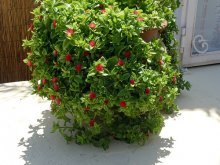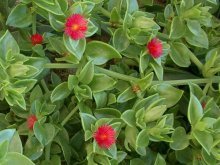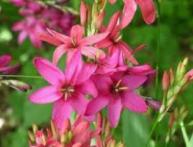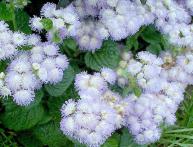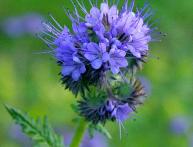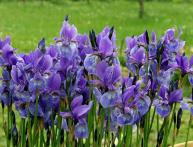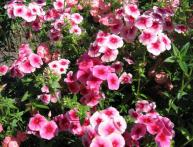Apthenia: a persistent guest from the sultry south
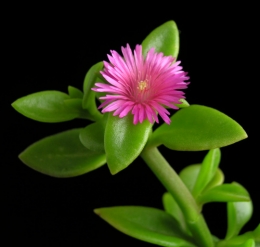
This evergreen succulent, which spreads along the ground with curly branches, looks very decorative. At the same time, the plant is relatively resistant and undemanding in care. That’s why our flower growers liked aptenia so much.
Content:
Aptenia in natural environment
Aptenia is a subshrub that grows up to half a meter throughout the year. Its leaves reach more than 5 centimeters in length and their width is about 3 centimeters. The leaf plates cover the papillae. The flowers do not form inflorescences and are planted on short stems.
The apthenia fruit is a water-absorbing capsule with tiny seeds. It ripens in a couple of months. The plant blooms very luxuriantly, with bright small flowers, in areas well lit by the sun.
In Africa and Australia, this plant easily survives drought, but does not tolerate frost. This sun-loving flower needs warmth, so it can be classified as a heat-resistant plant.
In its natural habitat, for example, in Buenos Aires, apthenia blooms from the beginning of spring until almost winter. The flowers usually bloom at noon. But indoor analogues of plants under different lighting conditions open in the morning.
The most common athenia is annual, but there are biennial and even perennial ones. However, its entire active period in its life cycle is about 4 months.
This flower has not yet been studied enough.Although it begins to bloom after all parts of the plant are saturated with salts in high concentrations. This leads to athenia leading to fruiting, after which the death of the annual occurs.
In Australia and California, this flower, adapted to the conditions, grows in depleted soils near landfills and along roads. The salty composition of the soil is important for it to accumulate moisture, so this plant can leach the soil, absorbing water-soluble salt from the soil and giving back insoluble dry salt.
It collects throughout the plant, collecting moisture. Salt also helps create “crystal” skin. It is also noteworthy that crystal apthenia inhibits the development of neighboring plants, throwing dry salt into the ground, from which the neighbors die. Since ancient times, Africans have included this plant in ritual drinks, because athenia juice is rich in psychotropic hallucinogens.
Apthenia cordifolia
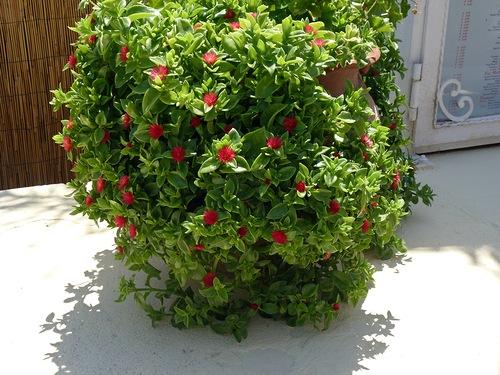
The most common in our area - creeping heart-leaved athenia. Its decorative effect makes the plant very expressive in hanging flowerpots. The stems of the plant, like thin hoses, hang 25-30 centimeters.
The leaves of this species are small, only about one and a half centimeters long. They are placed oppositely on the stem and have an inverted ovoid shape.
Aptenia blooms are small, deep pink and even scarlet. The flowers emerge from the axils of the leaves in the morning, are open all day, and die towards nightfall. The flower is no more than one and a half centimeters wide.
It is noteworthy that the plant itself has adapted to escape sunburn in the hot African savannah, as well as from excess evaporation.To do this, “crystal” cells develop in the tissues of this aptenia, forming a protective film that reflects dangerous rays and absorbs only the useful part of the radiation.
Breeders bred hybrid form flower in different shades of red. And the color of the leaves is formed from transitions of various shades - from greenish to brown.
Such hybrids, obtained by crossing different species, are very demanding on soils. They develop best in light, aero- and water-permeable soils.
Once flowering is completed, this insect-pollinated plant forms an angiosperm fruit capsule of four nests. Tiny poppies do not exceed 1 centimeter in length. It is not strange that its small seeds spill out into dust from the cocoon and multiply quite easily. Moreover, even fresh, just collected seeds germinate.
There are many subspecies of this popular aizoon plant. Aptenia grows in the dry part of Africa, although it is also found in other regions.
There are many other types of apthenia. But they are less popular in our area due to their inability to cope with the climate.
Growing Apthenia
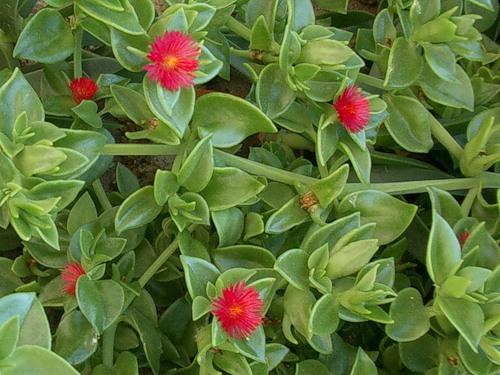
The most suitable growing temperature aptenia is considered to be 22 degrees. And since its lighting must be sufficient, the flower is grown on eastern and southern windows.
Plantings of this succulent are made rare, because it develops quickly, oppressing its neighbors. Aptenia is not added to flowerpots as a replant.
It is also important not to over-water the athenia. The plant can be placed in infertile alkaline soil. This type of aptenia easily takes root in saturated salt marshes.
It is popular as an ornamental plant.Growing occurs in open ground as a border, and in flowerpots as an hanging crop.
You can use any soil for indoor planting, the main thing is to drain it. Make holes in the bottom of the pot and cover it with a ball of good drainage. It's better to add sand. The soil mixture for aptenia includes:
- sand with leaf soil or turf
- loam and clay soil
- charcoal
Aptenia does not need fertilizer, so having planted it correctly, you can forget about frequent attention to it. In addition, during one growing season, athenia itself several times becomes an excellent fertilizer suitable for cacti and suculents.
Reproduction of this type of athenia is mainly by cuttings, because it very easily takes root either in water or in moist soil. The predominance of cutting propagation is also explained by the fact that it is very difficult to propagate apthenia from seeds.
Often not a single attempt is successful. Tiny seeds sown in the ground generally germinate well, but later seedlings die, due to excess moisture and for some other reasons.
Aptenia should be propagated in the fall, so that during the period of active development in the spring, the shoots can grow and take root for flowering in May. A young plant, revived from a flimsy cutting, blooms in the spring much faster than the old one. It happens that not even half a month passes from planting to flowering!
Aptenia is quite unpretentious, and in an open form of cultivation it does not require any care. The optimal planting location is sunny areas of flower beds. It needs to be watered moderately, and in winter - minimally.
Aptenia is grown throughout the entire former USSR. But at the same time, it should be provided with proper care and planting in a suitable environment.Of course, this plant will not develop without any attention. But if you do it at least periodically, then the flowers and greenery of Aptenia will constantly delight the eye with their lush beauty!
Admire the flowering of apthenia in the video:
Interesting information about the vegetable garden

